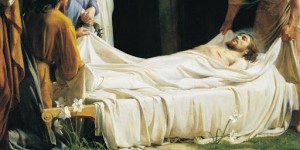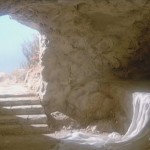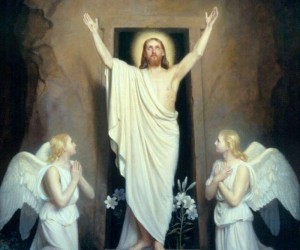Click here to read Part I of this series.
Click here to read Part II of this series.
Click here to read Part III of this series.
Click here to read Part IV of this series.
Click here to read Part V of this series.
Click here to read Part VI of this series.
A SURVEY OF THE DIFFERENT RESURRECTION HYPOTHESES PART VII: INFERENCE TO THE BEST EXPLANATION
How do historians figure out what a good historical hypothesis is? What criteria do they use? The model that can be used is called inference to the best explanation. This is a kind of reasoning in which you have a certain body of data to be explained – certain facts to be explained. In the case of the resurrection these facts would include the six facts which were spoken of previously. The historian then constructs a pool of live options for explaining this data. These various live options in the pool of explanations will be his hypothesis to try to explain the data.
Regarding the resurrection, various live options might include: the women went to the wrong tomb, or Jesus wasn’t really dead, or the disciples had hallucinatory experiences after the crucifixion, or this is all mythology, or that God raised Jesus of Nazareth from the dead. Then in order to determine or infer what is the best explanation, the historian asks, which one of these options, if true, would provide the best explanation of the data? You are not looking for the only explanation. You are not saying there aren’t any other live options. You are inferring to the best of these explanations. How do you determine what counts as a best explanation? What are the criteria that are going to be used to determine the best explanation?
In his book, Justifying Historical Descriptions, historian C. B. McCullagh lists six tests which historians use in determining what is the best explanation for given historical facts (C. Behan McCullagh, Justifying Historical Descriptions (Cambridge: Cambridge University Press, 1984), p. 19.). Some of these were mentioned already in Part II of this post.
Here are the criteria:
- Explanatory scope: The hypothesis with the best explanatory scope implies a greater variety of observable data. It will have a wide range of observable data that it will explain. One of the weaknesses of the hallucination hypothesis is that it has narrow explanatory scope. It explains the post-mortem appearances, but says nothing of the empty tomb. In order to account for the empty tomb, you have to conjoin some other hypothesis to the hallucination hypothesis to explain all the data.
- Explanatory power: The hypothesis with the most explanatory power is the hypothesis which makes the observable data more probable than it would have been otherwise. It has the power to explain the data. So you want to pick the hypothesis that has the greatest degree of explanatory power. Here the hallucination hypothesis is a good example of a hypothesis lacking explanatory power. How well does it explain the pos-mortem appearances of Jesus? How well does it explain what it purports to explain? Not very well. One of the things pointed out was, that if the disciples were to have hallucinated visions of Jesus, they would have projected visions of Jesus in glory in Abraham’s bosom where the righteous dead went to await the resurrection at the end of the world. In this case, hallucinations of Jesus would not have led to a belief in Jesus’ resurrection. It would have best led to a belief in Jesus’ assumption into heaven; not that he had been resurrected. Resurrection was a different category in Jewish thinking than an assumption into heaven. Thus the explanatory power of the hallucination hypothesis does not explain why the original disciples came to believe in and proclaim the resurrection of Jesus. This being one of the data to be explained – the origin of the belief in the resurrection.
- Plausibility: This has to do with the degree to which accepted knowledge implies the hypothesis. By accepted knowledge, it is meant both the background evidence, as well as the specific evidence in this case. This is compared to the degree in which the data would imply the falsity of the
 hypothesis. Plausibility means you take all your information and what is the degree to which it implies the truth of the hypothesis as opposed to implying the falsehood of the hypothesis. Which one is more plausible given the data? That the hypothesis is true or that it is false? Take the wrong tomb theory (which was not discussed) as an example. The theory is that the women went to the wrong tomb and found a gardener there who says your seeking Jesus of Nazareth he is not here. See the place where they lay him (pointing to some other tomb). Is that plausible? Not at all. If the women had made that mistake and began to proclaim the resurrection, all the Jewish authorities would have to do is point to the right tomb. Here the data points to its falsehood rather than to its truth.
hypothesis. Plausibility means you take all your information and what is the degree to which it implies the truth of the hypothesis as opposed to implying the falsehood of the hypothesis. Which one is more plausible given the data? That the hypothesis is true or that it is false? Take the wrong tomb theory (which was not discussed) as an example. The theory is that the women went to the wrong tomb and found a gardener there who says your seeking Jesus of Nazareth he is not here. See the place where they lay him (pointing to some other tomb). Is that plausible? Not at all. If the women had made that mistake and began to proclaim the resurrection, all the Jewish authorities would have to do is point to the right tomb. Here the data points to its falsehood rather than to its truth. - The degree to which the hypothesis is ad-hoc: You want a hypothesis that is less ad-hoc. In Latin ad-hoc means, “to this”. It means the degree to which the theory is sort of concocted just to explain “this”. It is sort of contrived. There is an artificiality about it that you wouldn’t have good reason to believe otherwise. If a theory is ad-hoc, it means there really isn’t much independent reason to believe it is true so you have to invent all kinds of new hypothesis just to explain this evidence for which you have no grounds to believe is true. This can be illustrated by the “twin theory” (another one not discussed in the post). This states that the best explanation for the resurrection of Jesus of Nazareth was that He had an unknown twin brother. Jesus wasn’t really born to Mary and Joseph. He and His brother were born to some other Jewish peasant lady and that in some way or another He got switched with Mary and Joseph’s baby. Mary and Joseph now thought that Jesus was their baby, when in fact He was the baby of somebody else. Jesus’ twin grew up independently from Him in some other town in Judea. Just at the time of the crucifixion, His brother came back to Jerusalem, saw that Jesus was crucified, stole the body out of the tomb, and presented Himself to the disciples who mistakenly thought that Jesus was risen from the dead. That is a theory that is ad-hoc. We have no reason to believe that Jesus had a twin brother. No reason to believe He was switched with some other baby. We have no reason to believe this other guy came back to Jerusalem just at the right time.
- It needs to be disconfirmed by fewer accepted beliefs: It must be disconfirmed by fewer accepted beliefs than any other competing hypothesis about the same subject; that is, when conjoined with accepted truths it must imply fewer observation statements and other statements which are believed to be false. If you add the hypothesis to accepted truths then fewer falsehoods will result. The apparent death theory is hugely disconfirmed by what we know about medical science and crucifixion – therefore it is hugely disconfirmed by accepted beliefs. Isn’t the hypothesis that Jesus was raised from the dead
 by God disconfirmed by accepted beliefs? No. Notice how the hypothesis is worded. The hypothesis is not that Jesus came back naturally from the dead. That is disconfirmed — hugely disconfirmed by what we know about medical science. The hypothesis is that God raised Jesus from the dead. That is in no way disconfirmed by what we know medical science tells us what happens naturally to someone who is dead. It would be a miracle for someone to come back from the dead. That is exactly what the resurrection hypothesis is and is not disconfirmed by any accepted beliefs about what happens naturally to people after they are dead. It would just be the old problems of miracles again. That certain people have a bias against miracles and don’t want to accept a supernatural explanation.
by God disconfirmed by accepted beliefs? No. Notice how the hypothesis is worded. The hypothesis is not that Jesus came back naturally from the dead. That is disconfirmed — hugely disconfirmed by what we know about medical science. The hypothesis is that God raised Jesus from the dead. That is in no way disconfirmed by what we know medical science tells us what happens naturally to someone who is dead. It would be a miracle for someone to come back from the dead. That is exactly what the resurrection hypothesis is and is not disconfirmed by any accepted beliefs about what happens naturally to people after they are dead. It would just be the old problems of miracles again. That certain people have a bias against miracles and don’t want to accept a supernatural explanation. - It exceeds its rival hypothesis in meeting criteria 1-5: This means that there is little chance that future discoveries will show one of the other hypothesis will eventually turn out to meet the first five criteria better than the accepted hypothesis. In order to be the best explanation, it must exceed its rival hypothesis in meeting conditions 1-5 to a good degree.
McCullagh sums up, “If the scope and strength of an explanation are very great, so that it explains a large number and variety of facts, many more than any competing explanation, then it is likely to be true.” (Justifying Historical Descriptions, p. 26)
The hypothesis “God raised Jesus from the dead” passes all these tests:
- It has great explanatory scope: it explains why the tomb was found empty, why the disciples saw post-mortem appearances of Jesus, and why the Christian faith came into being.
- It has great explanatory power: it explains why the body of Jesus was gone, why people repeatedly saw Jesus alive despite his earlier public execution, and so forth.
- It is plausible: given the historical context of Jesus’ own unparalleled life and claims, the resurrection serves as divine confirmation of those radical claims.
- It is not ad hoc or contrived: it requires only one additional hypothesis: that God exists. And even that needn’t be an additional hypothesis if one already believes that God exists.
- It is in accord with accepted beliefs: The hypothesis, “God raised Jesus from the dead,” doesn’t in any way conflict with the accepted belief that people don’t rise naturally from the dead. The Christian accepts that belief as wholeheartedly as he accepts the hypothesis that God raised Jesus from the dead.
- It far outstrips any of its rival hypotheses in meeting conditions 1-5: Down through history various alternative explanations of the facts have been offered, for example, the conspiracy hypothesis, the apparent death hypothesis, the hallucination hypothesis, and so forth. Such hypotheses have been almost universally rejected by contemporary scholarship. None of these naturalistic hypotheses succeeds in meeting the conditions as well as the resurrection hypothesis.
Now this puts the sceptical critic in a rather desperate situation. A few years ago, Dr. William Lane Craig (Christian apologist and philosopher) participated in a debate at the University of California, Irvine, on the resurrection of Jesus with Robert Gregory Cavin. Professor Cavin had written his doctoral dissertation on the resurrection, and he was thoroughly familiar with the evidence. Professor Cavin could not deny the facts of Jesus’ honorable burial, empty tomb, post-mortem appearances, and the origin of the disciples’ belief in the resurrection. His only recourse was to come up with some alternate explanation of those facts. And so Professor Cavin argued that Jesus of Nazareth had an unknown, identical twin brother, who was separated from Jesus as an infant and grew up independently, but who came back to Jerusalem at the time of the crucifixion, stole Jesus’ body out of the tomb, and presented himself to the disciples, who mistakenly inferred that Jesus was risen from the dead! This example is illustrative of the desperate lengths to which scepticism must go in order to refute the evidence for the resurrection of Jesus. Indeed, the evidence is so powerful that one of the world’s leading Jewish theologians, the late Pinchas Lapide, who taught at Hebrew University in Israel, declared himself convinced, on the basis of the evidence, that the God of Israel raised Jesus of Nazareth from the dead! (Pinchas Lapide, The Resurrection of Jesus, trans. Wilhelm C. Linss (London: SPCK, 1983))
The significance of the resurrection of Jesus lies in the fact that it is not just any old Joe Blow who has been raised from the dead, but Jesus of Nazareth, whose crucifixion was instigated by the Jewish leadership because of his blasphemous claims to divine authority. If this man has been raised from the dead, then the God whom he allegedly blasphemed has clearly vindicated his claims. Thus, in an age of religious relativism and pluralism, the resurrection of Jesus constitutes a solid rock on which Christians can take their stand for God’e self-revelation in Jesus.







Recent Comments